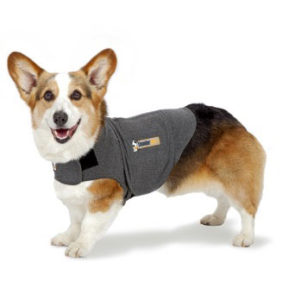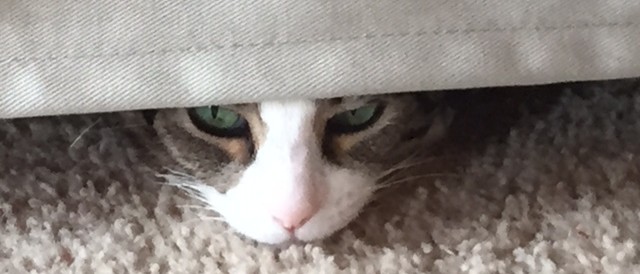Spring and summer can be rough. Thunderstorms are unpredictable, and fireworks seem to occur more often than just July 4th. Some pets aren’t phased, while others are downright terrified by these loud and unexplained noises.
Some pets are just anxious in general. Maybe they were not socialized properly during the formative months. Maybe they have a traumatic past. Sometimes every day life can be stressful or downright scary.
What to do?
Thirty years ago, vets all prescribed the same drug – acepromazine. It’s a sedative, available in a pill form, and is rather affordable. Those are all good things. The problem – while it sedates the pet and makes him less mobile, the anxiety is completely unaffected. So we have a dog or cat who is loopy, but just as terrified of the noises as with no drugs. They can’t show it, so the owners think “this works great.” However, being scared, then further confused by a drug, can actually make the fear worse! Skip the acepromazine. It’s good for keeping a dog quiet who just had major orthopedic surgery. It’s awful for scared dogs. Some specialists are suggesting dogs can even develop a PTSD type syndrome after the use of “ace” during high-stress events!
Thankfully, we’ve made great progress in the field of pet anxiety – both dogs and cats! There are many great products out there to help pets by addressing the underlying cause – the fear! Does one work for all pets? Of course not. But I have had many owners experience drastic improvement by using various combinations of products. The best part? Many of these are over the counter, and they are not drugs. So, they really can’t have side effects! Worst case scenario – it doesn’t really help, and you’re out $30. It does take a bit of trial and error to see what works best for each individual pet.
Here’s a few great options. Some of these are for situational anxiety, like storms and fireworks. Other are better for coping with daily life and long term generalized anxiety.
Exercise
This doesn’t cost a dime, and can only help! Obviously, not a solution for fireworks or thunderstorms, but for day-to-day anxiety in general. If your pet has separation anxiety, destructive behavior or any other stress, daily walks can make a huge difference! Many “bad behaviors” are from a combination of boredom, pent-up energy, and anxiety. Leaving the yard and sniffing around provides amazing mental stimulation for your dog. Here’s my articles on the power of daily walks and why leaving the yard (for your dog) is so important!
Pressure wraps (ie -Thundershirt, Anxiety Wrap, Calming Coat)
These are tight fitting jackets/vests that your dog or cat wears. The theory is twofold: it feels like a hug, and it also mimics swaddling, that comfortable feeling of being wrapped up tightly. Remember when you were little, you swore you heard a noise in the closet, and you pulled the covers up over your head and all around you?

Photo courtesy of Thundershirt.com
A bit like that, sort of. It is important to get the correct size, and to put it on your pet correctly! I cannot tell you how many owners use these wrong! It is not a fashion accessory – think of it as a medical device. It needs to be used properly to work. The shirt must be SNUG (think Spanx!). It’s made of stretchy material, and you can’t compress organs or hinder breathing, unless you are some angry body builder with a grudge over-tightening a shirt on a yorkie. So make it tight like a hug! (seriously, think girtle!)
And you may run across versions of “home-made” shirts using cloth or wraps online. Just stop. The vast majority are not effective, and actually CAN inhibit blood flow. Your pet won’t be any calmer if he can’t feel his legs because you had to try some wrap that worked more like a tourniquet! Stick with the ones made for pets.

How NOT to wear a thundershirt. Notice it hanging off the dog!
Pheromones
These come in a few forms. Calming collars(ie-Adaptil, Comfort Zone, Nurture Calm) generally go over better for dogs. There are also plug-ins (similar to room air fresheners) that are designed for dogs (Adaptil) or cats (Feliway). There are some different brands emerging as well, but Adaptil and Feliway are the original creators. When they first came out in the early 21st century, we vets all thought it was bogus. Pheromones? Really? But, the companies did some very good, well-controlled studies that showed their effectiveness. Then, once I started using them in practice, I realized that these do work for the majority of patients!
In dogs, the pheromone mimics a chemical produced by a nursing mother that says “mom is here, nothing to worry about.” In cats, it mimics the chemical in their muzzle that they are trying to spread when they rub their faces on objects. It sends the signal “you have marked all this. Everyone knows it’s yours.”
Again, it cannot hurt, it can only help! Be sure to read the fine print on the diffusers – many only cover about 600-800 square feet, and most houses are much larger than that! (You’ll need a couple). Also, the collars last about 30 days, and need to be replaced. There is also a spray available that you can spray bedding, cat trees, or even a bandana your dog can wear if you don’t need the collar for a whole 30 days. The sprays must be applied every 24 hours.
The good news? It takes on average 30-60 minutes for these to work!
L-Theanine (ie-Anxitane, Composure, Solliquin)
This is an amino acid – one of the lego pieces that make up the towers that are proteins – that is found in green tea leaves. (who comes up with this stuff?) It’s been demonstrated in good clinical studies to have a calming effect in dogs and cats. It can be given on an as needed basis, but in my opinion, I like it best when given daily. It can take a few days to start to work. It is basically a protein supplement, so there is little to no chance of side effects. Again, can’t hurt, so why not try it?
One of the first was Anxitane, which now and then goes on backorder and can sometimes be hard to get. There are many other products out there (some for people as well) so generic L-Theanine itself is very accessible – and affordable! Solliquin and Composure similar supplement types, and are both made by reputable veterinary manufacturers. Talk to your vet about what dose your pet needs. And yes, it also can be used in both dogs and cats!
Hydrolyzed milk protein (Zylkene, Royal Canin CALM Diet)
OK, green tea leaves and pheromones were one thing, but now we’re just starting to sound like hippies. Hey, if it helps a stressed out pet, hand me the tie-dye! Again, well-designed studies have shown the efficacy of hydrolyzed milk protein in terms of increasing a calm feeling in pets. Zylkene is only available from your veterinarian, but again, really has no side effects, so you have nothing to lose! Also, there is a prescription diet made by Royal Canin called “Calm.” It has the hydrolyzed milk protein, as well as tryptophan (yes, the infamous Thanksgiving Day amino acid!). Your vet has to prescribe it, but it’s a food. Again, it can’t hurt! And, it is available in both dog and cat formulations. There are some over-the-counter products with milk protein as well – talk to your veterinarian, as these often contain lower doses, and we want your pet getting help!
 Prescription Drugs
Prescription Drugs
These, obviously, your veterinarian has to prescribe, so I won’t go into detail on which one does what. Basically, the key here is we need to address the anxiety. Simply sedating the pet will make the owners happy (Bowser isn’t chewing the baseboards every time it thunders!) but doesn’t help the dog (Bowser was still freaking out on the inside!). A new drug has come out and is being heavily marketed, called Sileo. I love the company making it, but I’m not sure I like the drug for this purpose. It’s a sedative. We often use it to sedate dogs (and cats) for nail trims, x-rays, and even as a pre-anesthetic for surgery. We vets love it when we use it IV because we can reverse it – give a different shot and the animal wakes up soon! However, as far as we know, it does not directly address anxiety. Some vets are prescribing it and like it, and it is much better than acepromazine (OK, anything is better than acepromazine). I’m just not one of them. Maybe I’ll change my mind. If your vet suggests it, keep an open mind. Maybe I’m just overly cautious.
What works? Xanax is one I like a lot. And yes, many people take it too! Trazodone is another that has become my go-to in the past couple years. These can both be used for sudden needs, like fireworks and thunderstorms. I’ve found that trazodone twice a day, every day, during the two weeks leading up to fourth of July, or throughout storm season, is much more effective than the hit-or-miss dosing on as as-needed basis. In fact, for generalized anxiety, one of my dogs lives on lower-dose trazodone twice a day, every day, and we give higher doses for storms or fireworks. So there’s lots of flexibility with this drug. For long term needs, we have many additional anti-anxiety medications available, like fluoxetine (Prozac, Reconcile), amitriptyline (Elavil), and clomipramine (Clomicalm), to name just a few. These are given every day, and can take 4-6 weeks before any improvement is noticed. Obviously, these are not a quick fix, but might be a good long term solution for separation anxiety, fearful pets, etc. Your veterinarian can decide which is best for your pet.
Moral support helps the most! (AKA – LOVE!)
Perhaps the most important product is…YOU! We can pop pills, plug stuff in, have our pets wear clothes, but if we aren’t working with them, we will not be nearly as successful. The old school thinking was “never reward a pet who is scared, or you teach them that is a good behavior.” That is complete crap. Here’s the problem with that theory – we can train a behavior. We cannot train an emotion. Spiders freak me out (sorry, even dead ones). I can be trained to be in the room and pretend I’m cool with one walking next to me, but the panic I am feeling inside is unchanged.
So if your pet is scared, be there for him! Console him. Offer a special treat. You are not teaching him to be scared. You’re not reinforcing a behavior. You are teaching him that his owner does not suck. You are being a nice person with a little compassion. Your pet deserves it. Give a hug. Hide in the basement with him. Turn on the TV or radio for background noise to drown out some of the scariness. Close the blinds to the lightning is less obvious. Get a fun toy. Be there for him!
